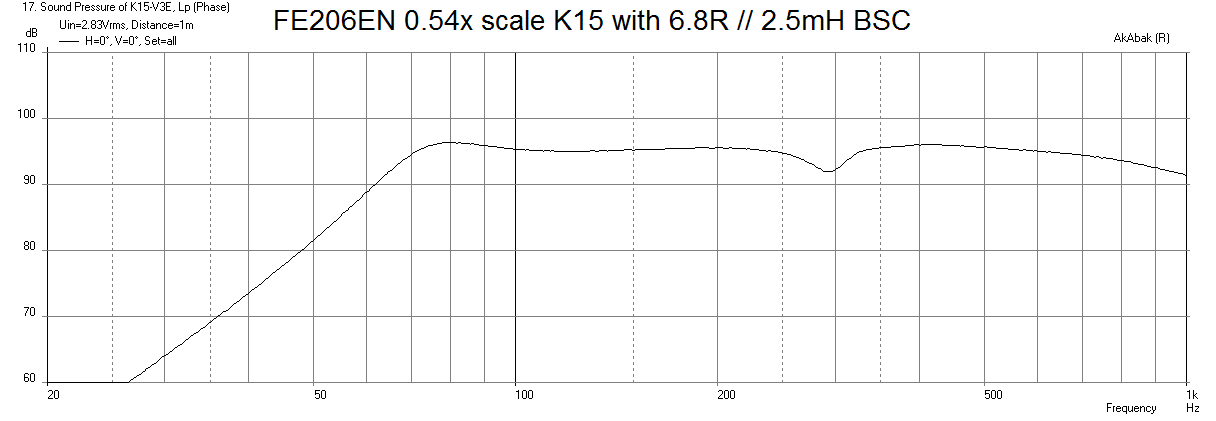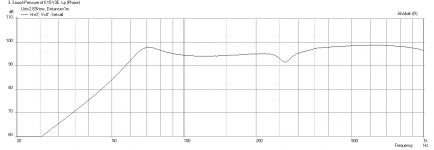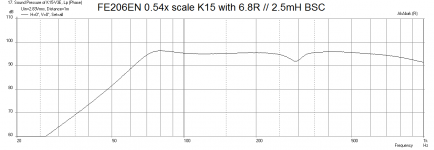I ran a sim of a FE206EN in a 0.60x scale K15 and the response is not ideal. Although there is a deeper bass extension, there is a bass hump at the knee - not good for accurate dynamics and low group delay. Better is a 0.54x scale K15, and also use a 2.5mH in parallel with a 6.8R BSC to flatten the response. You end up with a very nice circa 95dB sensitive system with an F3 of 64Hz.
Here is what I used for TS parameters:
Here is the 0.60x scale:

Here is the 0.54x scale with BSC:

Note that a K aperture that ends in a sharp cusp is important, do not use a slot termination.
Here is what I used for TS parameters:
Def_Driver 'FE206EN'
SD=206cm2 |Piston
fs=45.0Hz
Mms=12.2g
Qms=4.57
Qes=0.194
Re=6.8ohm
Le=0.0525mH
Vas=71.0L
Here is the 0.60x scale:

Here is the 0.54x scale with BSC:

Note that a K aperture that ends in a sharp cusp is important, do not use a slot termination.
Attachments
FWIW I don't think the low end is that strong - FE206EN in a K12 with stock tuning didn't seem to peak (?)
FE206EN plays nice in the old Karlsonette K12 and so should PS220
some in-room stuff
0.62 scale K15 with FE206EN
port fully open vs a 5/8" tall slot open

0.62 scale K15 - Beta10cx vs FE206EN (green trace = Beta10cx - 1K9 suckout was from wrong tweeter polarity)

0.62 scale K15/Fe206EN vs 1772 in a "high aspect" K8

1960's factory Karlson Eight (model with "fancy cupped" front chamber and two horizontal slot vents)
loaded with FE206EN
stock tuning on a K8 is around 95Hz - -this is probably away from room boundaries

Art Welter's Dad's "K8", built like a slit vent K12", IIRC is smoother than a factory K8
here's it with BetsyK - looks just as good with BG20 - Welter's "K8" has very large horizontal slots for its size
no damping material at all in the graph below. F6 probably ~100Hz away from boundaries
That Karlsonator 6 prototype with the excellent (and high qts ~0.7)) L.Cao F6 goes pretty low
plus F6 goes higher and smoother than the BK

FE206EN plays nice in the old Karlsonette K12 and so should PS220
some in-room stuff
0.62 scale K15 with FE206EN
port fully open vs a 5/8" tall slot open

0.62 scale K15 - Beta10cx vs FE206EN (green trace = Beta10cx - 1K9 suckout was from wrong tweeter polarity)

0.62 scale K15/Fe206EN vs 1772 in a "high aspect" K8

1960's factory Karlson Eight (model with "fancy cupped" front chamber and two horizontal slot vents)
loaded with FE206EN
stock tuning on a K8 is around 95Hz - -this is probably away from room boundaries

Art Welter's Dad's "K8", built like a slit vent K12", IIRC is smoother than a factory K8
here's it with BetsyK - looks just as good with BG20 - Welter's "K8" has very large horizontal slots for its size
no damping material at all in the graph below. F6 probably ~100Hz away from boundaries
That Karlsonator 6 prototype with the excellent (and high qts ~0.7)) L.Cao F6 goes pretty low
plus F6 goes higher and smoother than the BK

Last edited:
Hi Freddi,
I wonder if my TS params are off or something, or the model is just not correct for this case, as you don't show any of the low end at all, seems to start falling above 100Hz. Thanks for the reality check.
X
I wonder if my TS params are off or something, or the model is just not correct for this case, as you don't show any of the low end at all, seems to start falling above 100Hz. Thanks for the reality check.
X
hi X - - here's a couple of Qts for my FE206EN - looks like fs went up a bit but not sure of order
one thing with a regular K is the ramp up to cavity peak. - its around 210Hz in a "K10" size and a half octave higher in K8 size. Putting some 8 (say Beta 8CX) in a K10 with ~1/0.5 cubic foot chambers goes lower than the old/stronger Beta 10, but the 8 will have a few dB less output in 100-200Hz range while the peak around 210 remains the same. An extra cavity could be used to tame the peak.
typically outdoors and away from boundaries (other than sitting on the ground), K15 urns ~10dB at 50Hz, I would guess K12 F10 about a half octave higher than K15 when both are running "~99dB" rated speakers.
your XKi seems to go quite a bit lower than traditional K.
qts


btw, here's a 1772 in a rough K8 copy where I sealed off the slit vents then hacked a top vent with a
"multitool" 1772 is a smooth driver - this tiny K8 would probably be pretty good with a subwoofer

one thing with a regular K is the ramp up to cavity peak. - its around 210Hz in a "K10" size and a half octave higher in K8 size. Putting some 8 (say Beta 8CX) in a K10 with ~1/0.5 cubic foot chambers goes lower than the old/stronger Beta 10, but the 8 will have a few dB less output in 100-200Hz range while the peak around 210 remains the same. An extra cavity could be used to tame the peak.
typically outdoors and away from boundaries (other than sitting on the ground), K15 urns ~10dB at 50Hz, I would guess K12 F10 about a half octave higher than K15 when both are running "~99dB" rated speakers.
your XKi seems to go quite a bit lower than traditional K.
qts


btw, here's a 1772 in a rough K8 copy where I sealed off the slit vents then hacked a top vent with a
"multitool" 1772 is a smooth driver - this tiny K8 would probably be pretty good with a subwoofer

Last edited:
sorry to trouble you Freddi but do you have volumes/vent areas for the K12? if you play around with the FE206EN in a bass reflex spreadsheet that shows output SPL you will realise why the manufacturer did not recommend using in a bass reflex system. that drop in spl from 200Hz to 80hz is sort of unavoidable. if you adjust the vents the frequencies change but the magnitude of the drop stays. The L cao 6 is a more interesting driver. the optimum bass reflex volume is 71 litres. in a 45 litre bass reflex box it shows a bass boost but you are probably not interested because you are looking for a smaller K speaker dimension wise
K12's chambers are roughly 1.3/0.6 cubic foot. FE206EN sounds pretty good in a K12 (and more coherent on drums than a BLH where the horn output seems to lag the cone output). K12 are tuned small signal ~62Hz. LR baffle step compensation could be applied if deemed too bright. (IIRC, 206EN isn't as bright as Audio Gradient's AX08)
I've had: BetsyK, BG20, Fe206EN, AX08 in K12 - maybe AN8 (?) Julian Hirsch tried 8" speakers with K12 in his 1955 Karlson report.
I'd be happy to hear any K and Karlsonator suggestions - especially regular Karlson. A so called "SK8" (taller "K8") about the same bulk as K12 had 3-5dB less output in the 100-200Ha octave than the same W8-1772 in K12) I'm very interested in a high performance and smooth "K10" (probably with K-tube on top - I have DE250, and other decent 1" drivers)
I've had: BetsyK, BG20, Fe206EN, AX08 in K12 - maybe AN8 (?) Julian Hirsch tried 8" speakers with K12 in his 1955 Karlson report.
I'd be happy to hear any K and Karlsonator suggestions - especially regular Karlson. A so called "SK8" (taller "K8") about the same bulk as K12 had 3-5dB less output in the 100-200Ha octave than the same W8-1772 in K12) I'm very interested in a high performance and smooth "K10" (probably with K-tube on top - I have DE250, and other decent 1" drivers)
Last edited:
Thank you for your response Freddi. the K12 is more related to the XKi than the K15. I think you are only using one slot with FE206EN. if so if you reduce the slot length to 5 in you will get 50hz instead of 60 hz.
i have looked at the 10inch drivers you have mentioned in these posts and all need large boxes. would you be interested in a 0.47scale (0.1 volume) K15?
driver is small 4inch max spl 99dB
i have looked at the 10inch drivers you have mentioned in these posts and all need large boxes. would you be interested in a 0.47scale (0.1 volume) K15?
driver is small 4inch max spl 99dB
Last edited:
sorry Freddi. started by looking for drivers with the manufacturers you mentioned then got lazy and went to parts express coz they actually tell you what freq the driver would do in a vented box. w4-1879 was the only 4inch driver they said would do 50hz and it has xmax of 5mm. unfortunately its vas is high. you should look for one with lower vas if you want a smaller box,higher spl,xmax.... you have more experience in this
0.45 X is a nice size. On another coupler, K need to figure out why its response and input impedance looked strange when I moved the vent from a slot above the driver to a 3" hole at the top of the cabinet. he input impedance was something like a minimum of 12 ohms in the passband with the 3" hole vent located at the top of the front chamber (instead of looking like a regular reflex/bandpass box).
the cabinet is inverted in this picture - drive = Nirvana stamped frame Super-8

the cabinet is inverted in this picture - drive = Nirvana stamped frame Super-8

Last edited:
Hey Freddy, ever seen Electrovoice EVM12L used in a Karlson? I've got a couple that have been lying around for ages... to keep it relevant, the 'large space' would be my back yard...
cheers, Pete McK
cheers, Pete McK
hey PeteMcK 12L would be nice - I've used a B&C 12pe32 which is close in parameters. A K-tube on top igves nice treble quality but I'd guess a horn on top would be good outdoors. With K12, a K-tube could be mounted inside on the panel above the speaker.
A regular K12 would be a good enough housing for EV12L - I would avoid the skinny distributive slit port - although it sounds "good" - just for its sine performance - distributive/resistive ports in general get messy with sine. .
xtrk971 could do a Karlsonator sim for the 12L provided the data is in akabak input format
due to low qts, 12L would be a bit leaner than say Kappa12a
B&C 12PE32

here's the response and relative sensitivity of 12pe32 in the slit vent K12 above vs a "Large Advent"
- -also a pym1298 which is close to the Kappa12A

-
A regular K12 would be a good enough housing for EV12L - I would avoid the skinny distributive slit port - although it sounds "good" - just for its sine performance - distributive/resistive ports in general get messy with sine. .
xtrk971 could do a Karlsonator sim for the 12L provided the data is in akabak input format
due to low qts, 12L would be a bit leaner than say Kappa12a
B&C 12PE32

here's the response and relative sensitivity of 12pe32 in the slit vent K12 above vs a "Large Advent"
- -also a pym1298 which is close to the Kappa12A

-
Last edited:
(not sure if Mms is 37g ?)
Def_Driver EV12L|Vas=82.9 Mmd=29.92g
Sd=503.3cm2
fs=55
Mms=37
Qms=4.37
Qes=0.245
Re=5.2
BL=16.34
Le=1mH
Def_Driver EV12L|Vas=82.9 Mmd=29.92g
Sd=503.3cm2
fs=55
Mms=37
Qms=4.37
Qes=0.245
Re=5.2
BL=16.34
Le=1mH
sorry for not answering earlier Freddi. was at church camp. what would be the material thickness of your 0.45 K? about the slim K when you changed the port to the top you introduced quarter wave action. The tabaq uses this to good effect where the length is tuned to approx driver resonance
(not sure if Mms is 37g ?)
Def_Driver EV12L|Vas=82.9 Mmd=29.92g
Sd=503.3cm2
fs=55
Mms=37
Qms=4.37
Qes=0.245
Re=5.2
BL=16.34
Le=1mH
Did you want a sim with a 12/15 scale (0.8x scale) K15 for this driver?
it would be for PeteMcK - -I think the behavior of my 12pe32 would be close - it would be interesting to see the EV12L in a Karlsonator (awfully low tuning for a low Q driver)
John Karlson on Radio 1964
I uploaded this 4 years ago - its somewhat better in audio quality than the version on YouTube
There are pictures of my and other K-couplers
its can be dlownloaded and is under 700MB IIRC
https://archive.org/details/HiFI64PROJECTTRY4
I uploaded this 4 years ago - its somewhat better in audio quality than the version on YouTube
There are pictures of my and other K-couplers
its can be dlownloaded and is under 700MB IIRC
https://archive.org/details/HiFI64PROJECTTRY4
we know from Freddi's measurements k-coupled speakers have dips and peaks yet to most reports they sound good. according to X's model the original K has a sort of bass boost of about 4 db upto about 210hz compared to bass reflex speakers which may explain why to my aging ears drums sound more natural on them. But has anyone explained why with all those dips and peaks they still sound musical and totally not fatiguing even over periods in excess of 8 hours?
Narrow dips are not a problem. Our brains do a good job of filling in psychoacoustically. Peaks are another matter because they stand out. Peaks in the 2kHz to 5kHz range are the worst. Peaks in the 10kHz and above range are less audible but contribute to long term fatigue, whereas all the K stuff happens typically 1k and below.
K15 has great vocal reproduction with good recording & good coax - plus jaw dropping ability on bass transients - I would pick it over La Scala and Klipschcorn
K15 is great on plucked bass, bowed bass, cello, whatever.
K15 will blend with some midrange horns - I did not like it with a rectangular 250Hz/LE5 tractrix -
it did better with a large radial horn.
my Klipschorn measures very smooth with mic at midhorn level, but the bass and loeer midrange sounds "indirect""
my room walls are terrible - vinyl siding ->2x6 modern studs -> 3/4" flooring plywood -> 3/4" sheetrock
- they RING badly with a nasty "boooooommmmmmm" when tapped and the corner horn excites that resosnce
even with harpsichord or acoustic guitar. FWIW I've rewired one K-horn network for charge coupled with papaer-oil MBGO
caps and will build a less lossy version with DC-Link and 5uF pulse cap rated 1.2 mOhm ESR @100KHZ - that might
be too good for some amps ;^)
K-horn - -is the peak at the floor boundary a problem? PWK milked the good out those inexpensive- moderate Q K33.
North Reading made a lowpass section with notch filter to deal with that peak. I tried one and did not get much result
but my room walls are keeping the K-horn from ever being played.

K15 is great on plucked bass, bowed bass, cello, whatever.
K15 will blend with some midrange horns - I did not like it with a rectangular 250Hz/LE5 tractrix -
it did better with a large radial horn.
my Klipschorn measures very smooth with mic at midhorn level, but the bass and loeer midrange sounds "indirect""
my room walls are terrible - vinyl siding ->2x6 modern studs -> 3/4" flooring plywood -> 3/4" sheetrock
- they RING badly with a nasty "boooooommmmmmm" when tapped and the corner horn excites that resosnce
even with harpsichord or acoustic guitar. FWIW I've rewired one K-horn network for charge coupled with papaer-oil MBGO
caps and will build a less lossy version with DC-Link and 5uF pulse cap rated 1.2 mOhm ESR @100KHZ - that might
be too good for some amps ;^)
K-horn - -is the peak at the floor boundary a problem? PWK milked the good out those inexpensive- moderate Q K33.
North Reading made a lowpass section with notch filter to deal with that peak. I tried one and did not get much result
but my room walls are keeping the K-horn from ever being played.

Last edited:
- Home
- Loudspeakers
- Full Range
- A Speaker that Kicks Butt in Large Spaces

